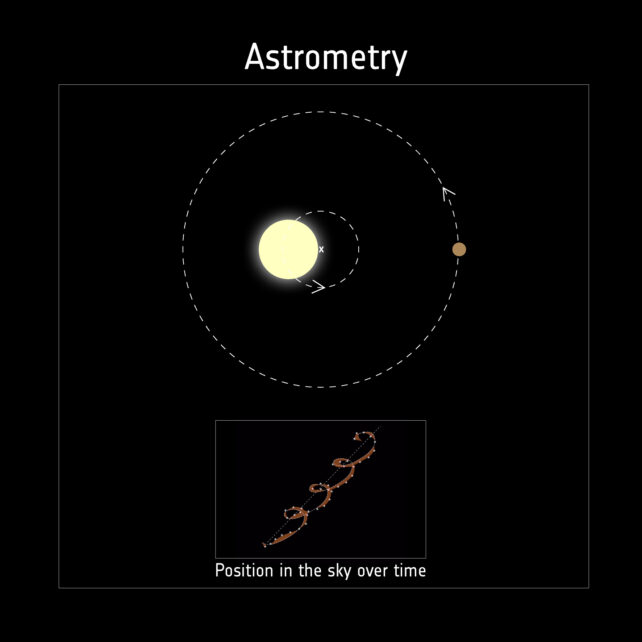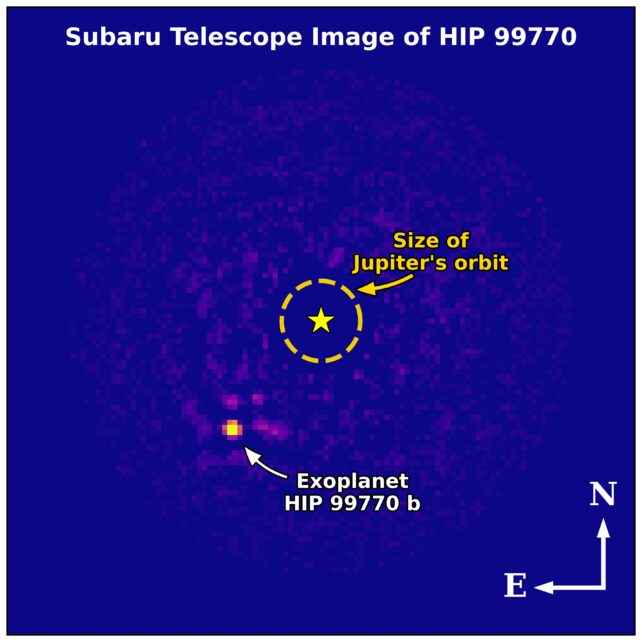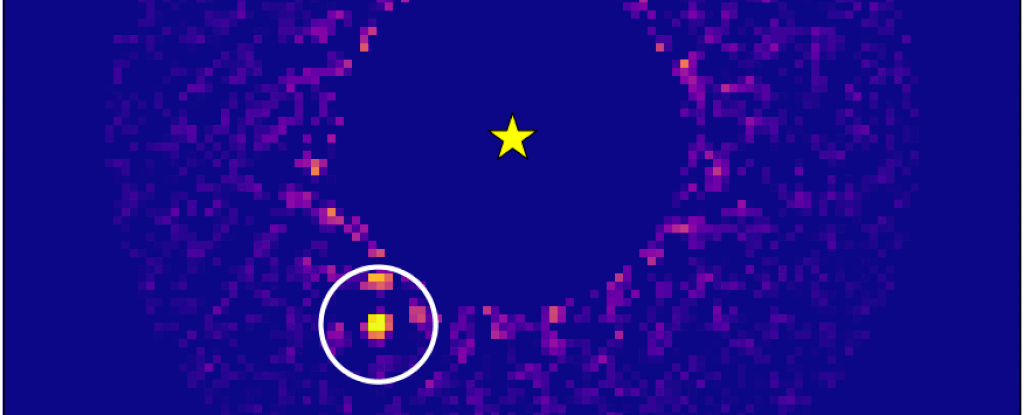The motion of a star as it makes its way through the galaxy has led to the discovery of a new alien world.
Using data from the Gaia spacecraft that's mapping the Milky Way, astronomers detected a kink in the motion of a star named HIP-99770, suggesting the presence of a nearby planet.
Follow-up observations then provided another treasure: a rare, direct image of the so-called exoplanet, subsequently named HIP-99770b. It's the first time that astrometry – tracking the movement of a star – has been combined with direct imaging to discover an orbiting planet.
These efforts constitute a new, and effective, way to search for worlds outside the Solar System, both to better understand the diversity of planets and planetary systems out there, and hunt for another world on which life may have bloomed.
"Performing both direct imaging and astrometry allows us to gain a full understanding of an exoplanet for the first time: measure its atmosphere, weigh it, and track its orbit all at once," says astrophysicist Thayne Currie of the Subaru Telescope and the University of Texas at San Antonio.
"This new approach for finding planets prefigures the way we will someday identify and characterize an Earth-twin around a nearby star."
Finding exoplanets is no simple matter. They're very small and very dim compared to the stars they orbit, and very far away. This means that we don't usually see them directly at all. Whatever light they might emit or reflect is drowned out by the blaze of their star. Instead, most of the more than 5,300 confirmed exoplanets identified to date have only been detected indirectly.
There are two main ways of doing this, and both are better at finding exoplanets that orbit their stars at close distances. The first is to look for transits, the faint and regular dips in starlight that reveal the presence of an orbiting exoplanet passing in front of the star.
The second is to look for changes in the wavelength of a star's light known as Doppler shifts as it moves about the mutual center of orbit it shares with the exoplanet.
That's because the gravity of the exoplanet affects the star, too; the two bodies move around this center in a sort of dance, like an Olympic hammer thrower. This motion in the star can be detected another way, too.

Stars aren't stationary in the Milky Way; they orbit the galactic center much like the planets of the Solar System orbit the Sun. So, rather than using changes in wavelengths, the astrometric technique looks for deviations from a straight line of movement as the star moves through the galaxy. This method can be used to detect exoplanets that Doppler shifts won't reveal, such as exoplanets circling in larger orbits around their stars.
And exoplanets that are at wider separations from their stars are better candidates for direct imaging, since they are far enough away that they can be distinguished from the stellar glare.
"Indirect planet detection methods are responsible for most exoplanet discoveries thus far. Using one of these methods, precision astrometry, told us where to look to try to image planets," Currie says. "And, as we found out, we can now see planets a lot easier."
The researchers went looking for direct imaging candidates in data collected by the Gaia and the Hipparcos spacecraft: European Space Agency projects tasked with mapping the Milky Way, including the positions and motions of the stars. This gave them a 25-year record of star positions.
Several stars showed evidence of a snaking wiggle that could be evidence of the presence of a giant exoplanet. The Subaru Telescope and the Keck Observatory in Hawai'i were put to work, looking for these worlds directly. And they snared a big one on one of the first stars they looked at.

HIP-99770b is an exoplanet between 14 and 16 times the mass and 1.05 times the radius of Jupiter, orbiting a star twice the mass of the Sun at a distance of 17 astronomical units. That's more than three times Jupiter's distance of 5 astronomical from the Sun, and just a little closer than Uranus's 19.8 astronomical unit-distance.
However, it receives about the same amount of radiation Jupiter receives, because the star HIP-99770 is so much brighter than our Sun. Because the team managed to image the exoplanet directly, they were able to take measurements of its properties. It's warmer and less cloudy than previously directly imaged exoplanets orbiting the star HR 8799, and its atmosphere shows evidence of both water and carbon monoxide.
The direct images also revealed the presence of an icy debris disk orbiting the star at a distance of around 150 astronomical units, similar to the Solar System's Kuiper Belt. Further research will no doubt probe the exoplanet further to see what else we can glean from direct imaging.
Meanwhile, the researchers are continuing to observe and analyze the 50 or so candidate stars they identified in the Gaia-Hipparcos data. HIP-99770b represents a proof of concept for their techniques, but they're not nearly done.
"This is the first of many discoveries from our Keck and Subaru imaging program that uses astrometry to select targets. We already have additional discoveries that will be announced later this year and next year," Currie says.
He adds, "We are now in a new era for imaging other worlds."
The research has been published in Science.
